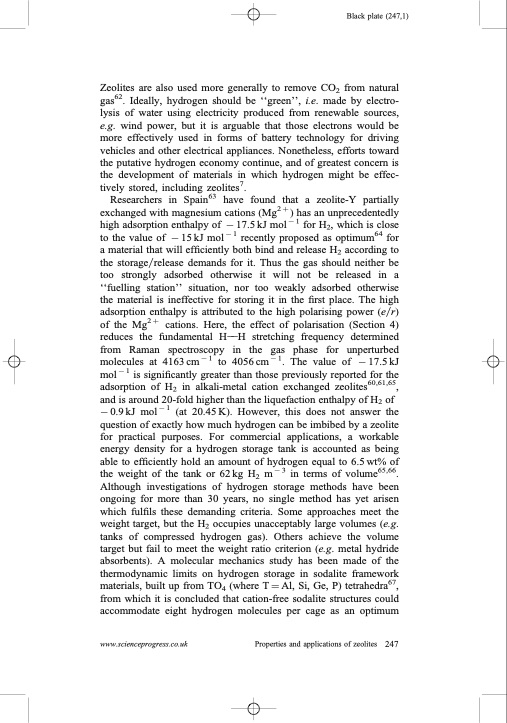
PDF Publication Title:
Text from PDF Page: 025
Black plate (247,1) Zeolites are also used more generally to remove CO2 from natural gas62. Ideally, hydrogen should be ‘‘green’’, i.e. made by electro- lysis of water using electricity produced from renewable sources, e.g. wind power, but it is arguable that those electrons would be more effectively used in forms of battery technology for driving vehicles and other electrical appliances. Nonetheless, efforts toward the putative hydrogen economy continue, and of greatest concern is the development of materials in which hydrogen might be effec- tively stored, including zeolites7. Researchers in Spain63 have found that a zeolite-Y partially exchanged with magnesium cations (Mg2 þ ) has an unprecedentedly high adsorption enthalpy of 17.5 kJ mol 1 for H2, which is close to the value of 15 kJ mol 1 recently proposed as optimum64 for a material that will efficiently both bind and release H2 according to the storageyrelease demands for it. Thus the gas should neither be too strongly adsorbed otherwise it will not be released in a ‘‘fuelling station’’ situation, nor too weakly adsorbed otherwise the material is ineffective for storing it in the first place. The high adsorption enthalpy is attributed to the high polarising power (eyr) of the Mg2 þ cations. Here, the effect of polarisation (Section 4) reduces the fundamental H2H stretching frequency determined from Raman spectroscopy in the gas phase for unperturbed molecules at 4163cm 1 to 4056cm 1. The value of 17.5kJ mol 1 is significantly greater than those previously reported for the adsorption of H2 in alkali-metal cation exchanged zeolites60,61,65, and is around 20-fold higher than the liquefaction enthalpy of H2 of 0.9 kJ mol 1 (at 20.45 K). However, this does not answer the question of exactly how much hydrogen can be imbibed by a zeolite for practical purposes. For commercial applications, a workable energy density for a hydrogen storage tank is accounted as being able to efficiently hold an amount of hydrogen equal to 6.5 wt% of the weight of the tank or 62 kg H2 m 3 in terms of volume65,66. Although investigations of hydrogen storage methods have been ongoing for more than 30 years, no single method has yet arisen which fulfils these demanding criteria. Some approaches meet the weight target, but the H2 occupies unacceptably large volumes (e.g. tanks of compressed hydrogen gas). Others achieve the volume target but fail to meet the weight ratio criterion (e.g. metal hydride absorbents). A molecular mechanics study has been made of the thermodynamic limits on hydrogen storage in sodalite framework materials, built up from TO4 (where T 1⁄4 Al, Si, Ge, P) tetrahedra67, from which it is concluded that cation-free sodalite structures could accommodate eight hydrogen molecules per cage as an optimum www.scienceprogress.co.uk Properties and applications of zeolites 247PDF Image | Properties and applications of zeolites

PDF Search Title:
Properties and applications of zeolitesOriginal File Name Searched:
003685010x12800828155007.pdfDIY PDF Search: Google It | Yahoo | Bing
CO2 Organic Rankine Cycle Experimenter Platform The supercritical CO2 phase change system is both a heat pump and organic rankine cycle which can be used for those purposes and as a supercritical extractor for advanced subcritical and supercritical extraction technology. Uses include producing nanoparticles, precious metal CO2 extraction, lithium battery recycling, and other applications... More Info
Heat Pumps CO2 ORC Heat Pump System Platform More Info
| CONTACT TEL: 608-238-6001 Email: greg@infinityturbine.com | RSS | AMP |